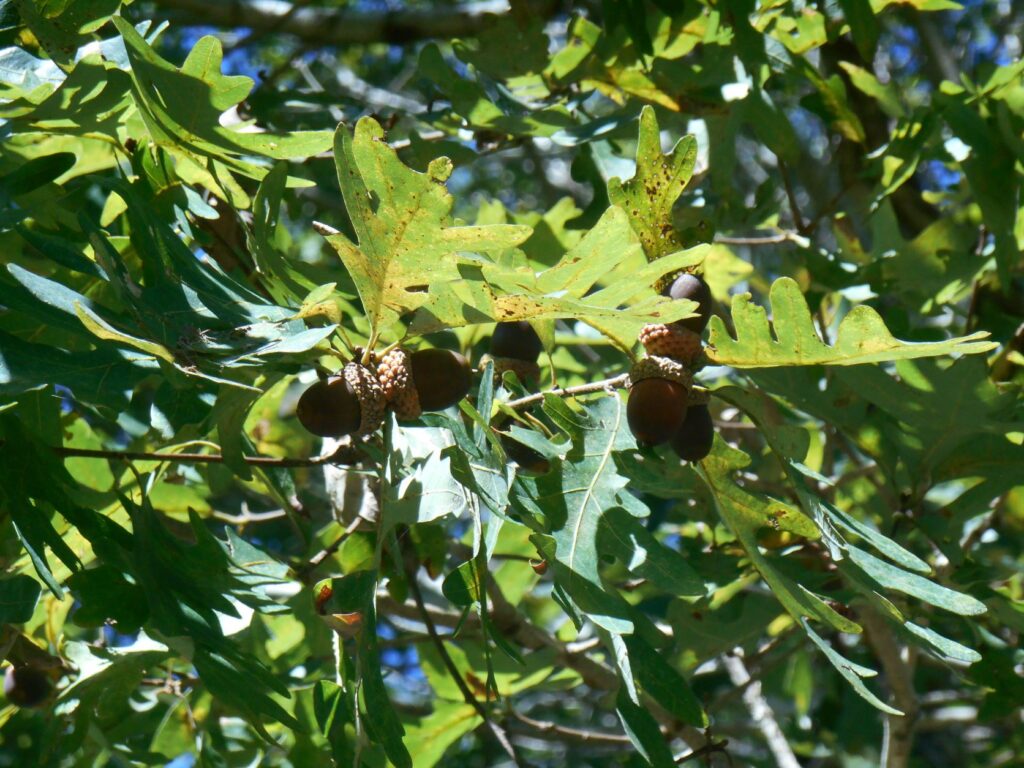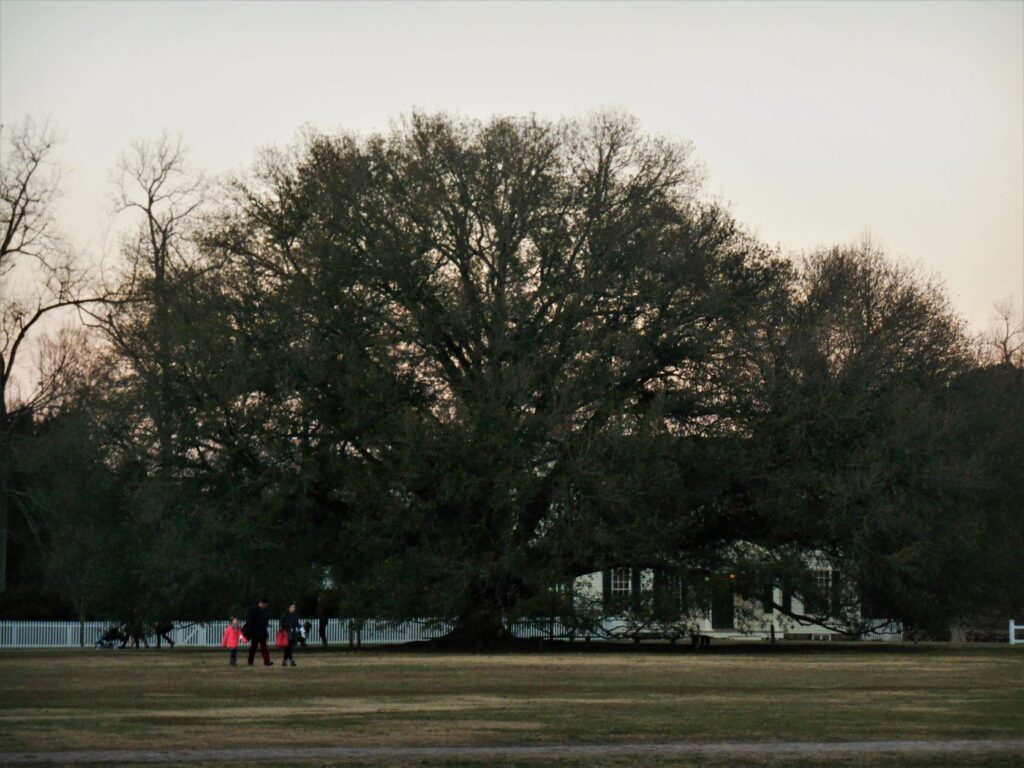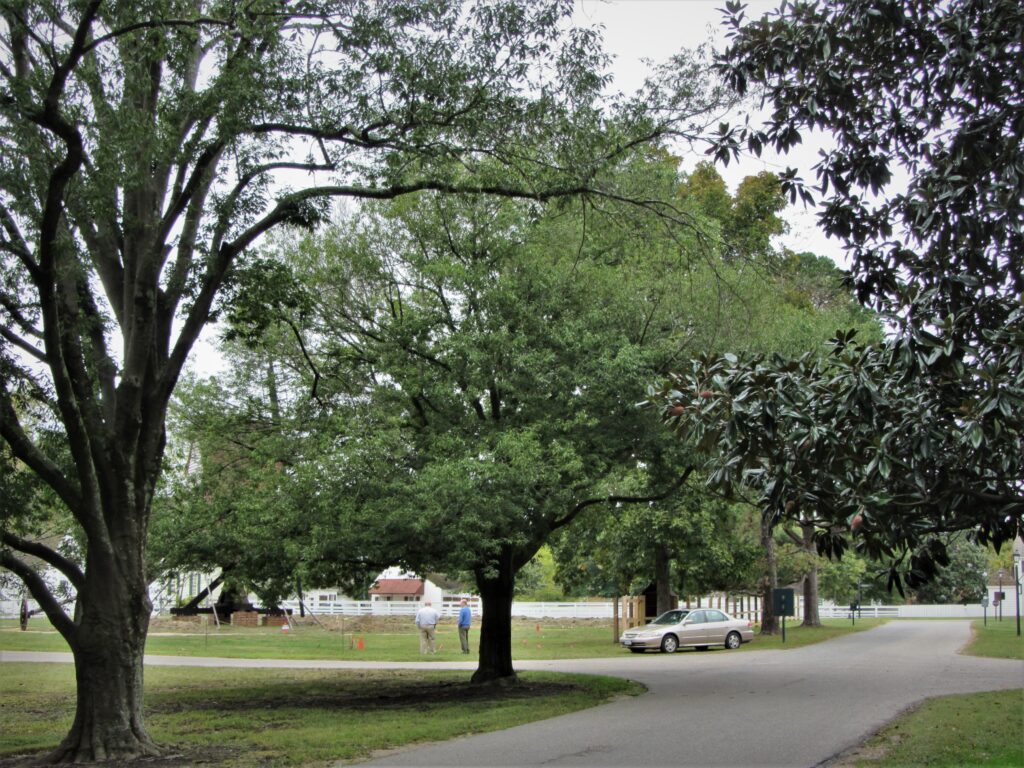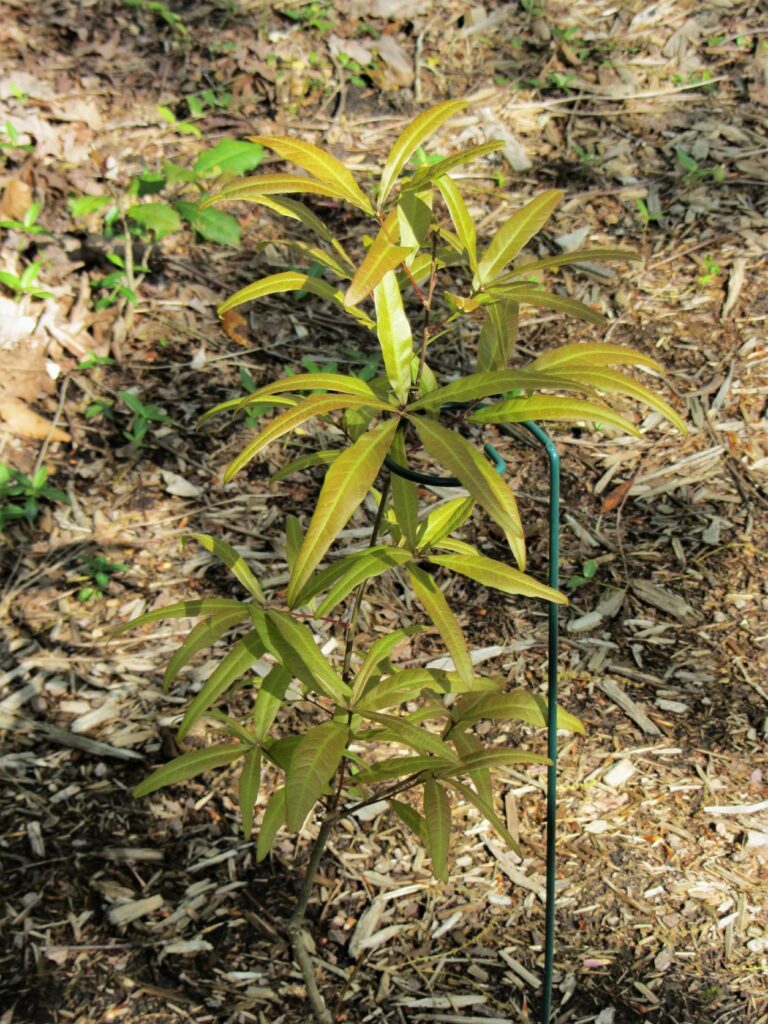From History and Legends to My Own Front Yard: The Beautiful Oak
At the intersection of myth, fantasy, and living reality stands a towering oak tree, covered in plump acorns. More than 400 species of oaks grow across temperate and tropical regions of North America, Europe and Asia, with 90 species here in the United States and another 160 species growing in Mexico. China has 100 different types of oak.
Types of Oaks
All oaks, members of the Fagaceae family along with beech and chestnut trees, produce acorns. Some, like our common live oak and the beautiful Chinese evergreen oak, may be evergreen species. Others are deciduous, turning shades of red, yellow or orange before their leaves turn brown and fall. Oak trees may be identified, even in winter, by their distinctive clusters of buds at the tip of each branch.

Q. alba Acorns on white oak trees ripen within a year. White oaks have rounded lobes on their leaves.
The large number of oak species may be further divided in the ‘white oak’ group and the ‘red/black’ oak group. Acorns on white oaks mature within a year, while red/black oak species require almost two years for their acorns to mature. The lobes of white oak leaves are rounded, while the lobes on red oak leaves each end in a tiny, sharp point. Some oaks, like our swamp chestnut oak, thrive in wet soils while other species thrive in arid regions. Oaks are renowned for their ability to thrive on poor, spoiled soils with a variety of soil chemistries.
History
Oaks, Quercus species, were already long-lived survivors on our planet long before the first humans walked beneath them. Oak fossils found in Oregon date to around 44 million years ago. Oak pollen, found in Austria, dates to 11 million years earlier. Oaks grew and spread from one region of Earth to another as continents were drifting, seas were forming and drying up, and oceans were rising and falling to shape the familiar Earth we know today.

Q. coccinea Acorns on red oaks ripen in their second year. When immature acorns drop in the wind, they aren’t yet ready to grow. Recognize red/black oaks by the sharp point on the lobes of their leaves.
A Keystone Species
The archetypal ‘Giving Tree,’ oaks remain a keystone species wherever they grow. Not only do they provide edible, protein rich acorns, gathered and eaten by early humans; their acorns also feed many birds and mammals. Certain wasps lay their eggs within developing acorns. Oak leaves support hundreds of varieties of insect larvae, and insects live in the crevices of oak bark and in their branches, finding shelter through the winter months.
An oak’s canopy provides shelter to many species of birds and small mammals, like squirrels. Birds feast on larvae and small insects living on oak leaves and branches throughout the year. Since many deciduous oak trees hold their leaves through the winter, there is extra protection for the small animals who shelter there.

The Compton Oak grows in Colonial Williamsburg. It is a naturally occurring hybrid between Q. virginiana, our native Southern live oak, and Q. lyrata, the overcup oak. It has grown here since reconstruction efforts in this area during the 1930.
The previous season’s leaves, of some species, fall in the spring as buds break and new leaves and catkins emerge. The falling leaves mulch and enrich the soil around the tree’s roots, while also providing shelter and food for the thousands of tiny animals and microorganisms living in the top few inches of soil beneath the tree. Roots of an oak tree spread well beyond its canopy and penetrate deeply into the soil. Its roots live in harmony with mycorrhizal fungi, bacteria, and the roots of many other plants to store and share food produced by the leafy canopy.
A single oak tree can live for centuries; a few of the longest-lived oaks may live for 1000 years or more. The Major Oak in Sherwood Forest has grown through much of modern British history, dating back to 800 to 1000 years ago. This English oak’s canopy covers 28 meters and its hollow trunk is large enough for people to gather inside of it.
Throughout their long lives oak trees provide shelter and feed the community around them. Once harvested, their wood may last for centuries more as tools, musical instruments, furniture, and as roof beams and paneling in various buildings. Oak was considered a superior wood for building ships, wine barrels, weapons, and many other items, because of the strength of its grain, and because the tannins in oak help protect it from insect damage, fungus, and rot.
Legend tells us that long ago in the mists of time, a band of wealthy adventurers used oak seedlings to mark the tiny island in Mahone Bay, off the coast of Nova Scotia, where they buried their treasure. Now known as ‘Oak Island,’ the legend tells us that those oaks, now all gone, were of a species native to the Mediterranean region, not a species native to North America. Just as humans have carried acorns from one place to another to spread the most desirable trees around, so blue jays and squirrels spread acorns from here to there in their annual efforts to store up food for the coming winter.

Q. myrsinifolia Chinese evergreen oak, or bamboo leaf oak, is another evergreen oak that grows in Williamsburg.
Oaks, Symbols of Strength, Endurance and Wisdom
Oak trees, symbols of strength and wisdom, are the national tree of the United States, Great Britain, Germany, and at least 14 additional countries. Oak trees have been associated throughout history with various gods including Zeus, Taranis and Thor. A variety of religious observances throughout the centuries involved oak trees, and Celtic Druids worshiped in open air sanctuaries beneath ancient oak trees, particularly the legendary English Oak, Q. robur.
Oak trees were one of the two ‘Kings of the forest” in Celtic culture, ruling from spring when their leaves emerge until they drop in autumn, when the Holly King began its rule over the dark half of the year. Oaks were one of the trees honored in the old Celtic Ogham Tree Alphabet as the seventh letter, ‘Dair.’
Different oak species attain different heights and spread, but oaks are generally considered to be tall, mighty trees. An American white oak, Q. alba, can grow to more than 100’ tall and 80’ wide. Southern red oaks, Q. falcata, routinely grow to around 60’-100’ tall with a 50-60’ spread. The live oak, Q. virginiana, can grow to more than 100’ wide, though not as tall. Most oaks average between 50 and 70 feet tall, though certain species grow taller with age.

Q. michauxii Swamp Chestnut oak is common in our area. It is a white oak, producing abundant acorns each year. It grows to around 90′ tall with a wide, rounded canopy.
Oaks as Food and Medicine
Native Americans, as well as early humans throughout Europe, the Mediterranean region and Asia, found ways to use acorns for food. Roasted, boiled, ground into flour, these nuts were collected and carried when groups were on the move, particularly before pistachios and almonds were domesticated and grown in orchards.
The tannins in oak are mildly poisonous. Eating oak leaves and acorns can cause sickness in some livestock. Boiling removes the tannins, making them safe for people to eat in greater quantities. Some oak trees, like our white oak, produce better food quality acorns than some other species. Oak bark is used to tan leather, and some species have medicinal qualities.

Q. virginiana grows on Duke of Gloucester Street in Colonial Williamsburg. It remains green in December when other oaks have already lost their luster.
Oak Trees at Home
As revered as trees of the oak genus may be in our history and myths, the average homeowner may hesitate to plant an oak near their home, for fear of it falling, or dropping large branches in a storm. As valuable as oaks have been to communities throughout history, that same homeowner may not want to make the effort each autumn to clean up the fallen leaves and acorns. I remember walking across my parents’ front yard one mast year, crunching with every step, as their yard was covered in fallen acorns, beginning to sprout there on top of the ground.
Oaks planted singly are far more vulnerable to wind. Planting a ‘grove’ of oaks, as they grow in nature, allows their roots to intertwine and their trunks and branches to support one another when the wind blows. Always plant oaks a safe distance away from buildings, leaving the trees room to develop and spread as they grow.
Leaves may be chopped with a lawn mower or other shredding equipment and left in place to mulch and enrich the soil. The leaf mulch helps retain rainwater and prevent run-off. It feeds the soil as it composts in place. Besides, it is a huge challenge to grow grass in the shade of an oak tree. It is much wiser to mulch at least as far as the drip line of outer branches. Grow ground cover perennials that tolerate dry shade, like Hellebores and Christmas ferns, under the canopy of oaks.
The shade cast by oaks greatly reduces energy bills, because a shaded roof helps moderate the temperature in and around a home. Allowing the trees’ canopy to absorb and transform sunlight protects the home, and the family who lives there, from the burning sun.

Q. phellos Willow oak is deciduous, although its leaves are similar in size and shape to Southern live oak’s leaves.
As oak leaves absorb sunlight, they also absorb carbon, and other pollutants, from the air. A mature oak tree can sequester about 48 pounds of carbon annually, or around a ton of carbon by the time it reaches 40 years of age. As the tree breaks down water molecules to produce sugars with the carbon, it releases oxygen back into the atmosphere. A tree breathes, just as we do, but the gas exchange is in reverse. Trees fill the air with fresh oxygen and water vapor, while using the carbon that warms our planet, to grow.
Squirrels, chipmunks, deer and birds make quick work of fallen acorns. Acorns provide important food to help wildlife survive the winter. In years with few acorns, deer browsing puts more pressure on vegetation than in those years when they can eat acorns to survive until spring.

Q. virginiana This small Southern live oak, purchased bare root from the Arbor Day Foundation, requires protection from grazing deer. They have pruned it back several times during the winter when food is scarce.
Planting Oak Trees
If you happen to find healthy acorns beneath an oak tree you admire, collect them to plant more trees of that type. Inspect each acorn for tiny tell-tale holes that indicate a wasp larva has already used that acorn as its home. If there are no holes, and the acorn is intact, float it in warm water to see whether it sinks or floats. If it sinks, it is a viable acorn ready to grow. Find instructions for starting acorns, and other tree seeds, here.

Q. myrsinifolia Plant only those acorns that sink to the bottom. Acorns that float likely won’t germinate.
If you decide to just plant the acorn where you want the tree to grow, first spray it with a product like Repels-All or Plantskydd, to offer it some protection from squirrels and other rodents that can smell it and eat it before it germinates. You can cut the bottom out of a plastic nursery pot and bury the pot first, leaving a couple of inches above grade. Leave the pot in place for the first couple of years, then pull it up once the seedling tree no longer needs protection. Better yet, use a composite pot made from biodegradable materials, or even a cardboard box, that will compost by the time the tree’s roots need more space.
Fill the pot with compost mixed with the natural soil, plant the acorn an inch or two deep, and mulch the top of the pot with chopped leaves or shredded bark. The pot will offer some protection from burrowing rodents. You might peg down some chicken wire above your planting spot to protect the acorn from digging squirrels and birds. You can remove the chicken wire in a few months, as the tree begins to grow. Your young tree will need protection from deer for several years to come, as seedling trees are a tasty treat for herbivores.
Keep your seedling tree watered during dry spells and mulch the area around it, taking care to not allow the mulch to touch the seedling tree’s trunk. Seedling trees grow best in dappled, partial sunlight beneath an established canopy. If planting in an unshaded lawn, make sure to keep the tree watered and watch for scorching during the first summer or two. Young oak trees grow quickly, easily gaining a foot or more of height each year. Your little seedling will mature more quickly than you would expect.
If you find a volunteer oak seedling in your yard, you will need to decide whether it can grow to maturity where it is planted. If you need to move it, carefully dig out the roots during its first two to three years of growth. Beyond that, it may be too large to get all its roots. Moving it will be hard on the tree. You’ll want to trim back the top growth by at least a third so the roots can support the branches as they get established. Prune roots by digging a trench around the tree in spring, before moving the tree in autumn at leaf drop, or during the winter. Try not to move a tree after mid-March in our area, because it won’t have time to establish before it leafs out, and summer’s heat returns.
For all of their mystique, ecological benefits, and rich history, the main reason to grow oak trees is for their beauty. One of the most graceful and stately trees, oaks grow symmetrically and shine with rich color through every season of the year. Choose an evergreen oak where it is warm enough to support them. Choose an oak with beautiful fall color, like Q. rubra, the Northern red oak or Q. palustris, the pin oak. Or simply learn to love the oak already growing in your yard. These trees have invited close relationships with people from the mists of history until the present day. In this age of climate change, we need their many gifts more than ever.
To Learn More:
Dirr, Michael A. Dirr’s Encyclopedia of Trees and Shrubs. Timber Press. 2016.
Dirr, Michael A. and Charles W. Heuser, Jr. The Reference Manual of Woody Plant Propagation From Seed to Tissue Culture. Varsity Press, Incorporated. 2006.
Dove, Tony and Ginger Woolridge. Essential Native trees and Shrubs for the Eastern United States. Bunker Hill Studio Books. 2018.
Kirkman, Katherine L., Claud L. Brown and Donald J. Leopold. Native Trees of the Southeast: An Identification Guide. Timber Press. 2007.
Tallamy, Douglas. The Nature of Oaks: The Rich Ecology of Our Most Essential Native Trees. Timber Press. 2021.
https://plants.ces.ncsu.edu/plants/quercus/
https://www.internationaloaksociety.org/
All Photos by E. L. McCoy
Appreciation to Ricklin Brown, JCCW Master Gardener Tree Steward, for assistance with editing











